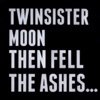 With a few exceptions, most of Mehdi Ameziane's recording career can be broken down into two simple categories: "great albums" and "albums that would have been great if they had been pared down a bit." Then Fell the Ashes... happily falls quite squarely in the former category. There is definitely some evidence here that Mehdi is continuing to evolve and improve, but the more important thing is that this is one of the most perfect distillations of everything that makes TwinSisterMoon so unique and wonderful. This is one of my favorite albums of 2010.
With a few exceptions, most of Mehdi Ameziane's recording career can be broken down into two simple categories: "great albums" and "albums that would have been great if they had been pared down a bit." Then Fell the Ashes... happily falls quite squarely in the former category. There is definitely some evidence here that Mehdi is continuing to evolve and improve, but the more important thing is that this is one of the most perfect distillations of everything that makes TwinSisterMoon so unique and wonderful. This is one of my favorite albums of 2010.
I have always preferred the darkly psychedelic drone side of Ameziane's work to his folkier pieces, so I was quite pleased to discover that the bulk of Then Fell the Ashes... is devoted to his more quasi-ritualistic, otherworldly, and abstract leanings.In fact, the entire second side of the record is filled by one such work, the overwhelmingly beautiful 25-minute title piece.It is hard to make me rabidly enthusiastic about drone music, but "Then Fell the Ashes..." is just staggeringly perfect in so many ways: there is a head-spinning amount of textural activity occurring, it is hugely powerful, it's filled with great instrumental passages, and it all seamlessly flows from crushingly dense to ghostly to fragilely melancholy without any lapses in majesty or vitality.The sad, oddly-timed cascade of guitar and piano notes near the middle stood out as particularly sublime, but I was also very impressed with how it unexpectedly evolved into an actual song at the end, like the closing credit music of an especially hallucinatory nightmare. I'm a big fan of unconventional song structures that aren't clumsy or jarring.
While "Then Fell the Ashes..." is certainly pretty stunning from a compositional standpoint, I was equally struck by Mehdi's skill as a producer and arranger.He weaves together an absurd number of tracks and instruments here, all of which are shimmering, flanging, rattling, swelling, or fading in some way, yet it never sounds cluttered or muddy, just gritty, psychotropic, and enveloping.Making drone music sound visceral, organic, and detached from our time is an art form all its own—I can't fathom how long it must have have taken him to record and mix such a piece.
The six pieces on the first side maintain a similar level of excellence.My favorites are (predictably) the more drone-themed ones, particularly the massive "Black Nebulae," which almost seems to breathe in an ominously Lovecraftian way. "The Big Sand" is equally wonderful, though markedly less unsettling.In fact, the coda is almost pastoral, as the howling pagan pipes give way to quivering organs (or treated flutes), field recordings of water and birds, and an elegantly melodic acoustic guitar motif.
The four brief "songs" are pleasant enough in a "tape hiss-damaged recording of Vashti Bunyan" kind of way, but they don’t pack quite the wallop of their lengthier, more maximalist counterparts.I'm glad they are included though; as they're essential from a sequencing perspective: 18 solid minutes of heavy psychedelic drone would be exhausting.The occasional oases of space and intimacy go a long way towards heightening the impact of the album's denser pieces.Also, I am pleased that the neo-folk songs are less oppressively sad than usual ("Trailer" could actually be described unironically as catchy).I suspect Mehdi is making an effort to broaden to expand his mood palette a bit and it seems to be an experiment that is working very well so far.
I expect to like every TwinSisterMoon release at this point, but Then Fell the Ashes... exceeded my expectations in every way: it sounds awesome, it doesn’t resemble anyone else, the melodies are great, the heavy parts are elephantine, and it all flows beautifully.Also, it seems like Mehdi is becoming more skilled at finding the ideal lengths for his songs on a case-by-case basis.This is a near-flawless and remarkably listenable album. Anyone curious about checking out TwinSisterMoon or Natural Snow Buildings would be wise to start here.
samples:
Read More

